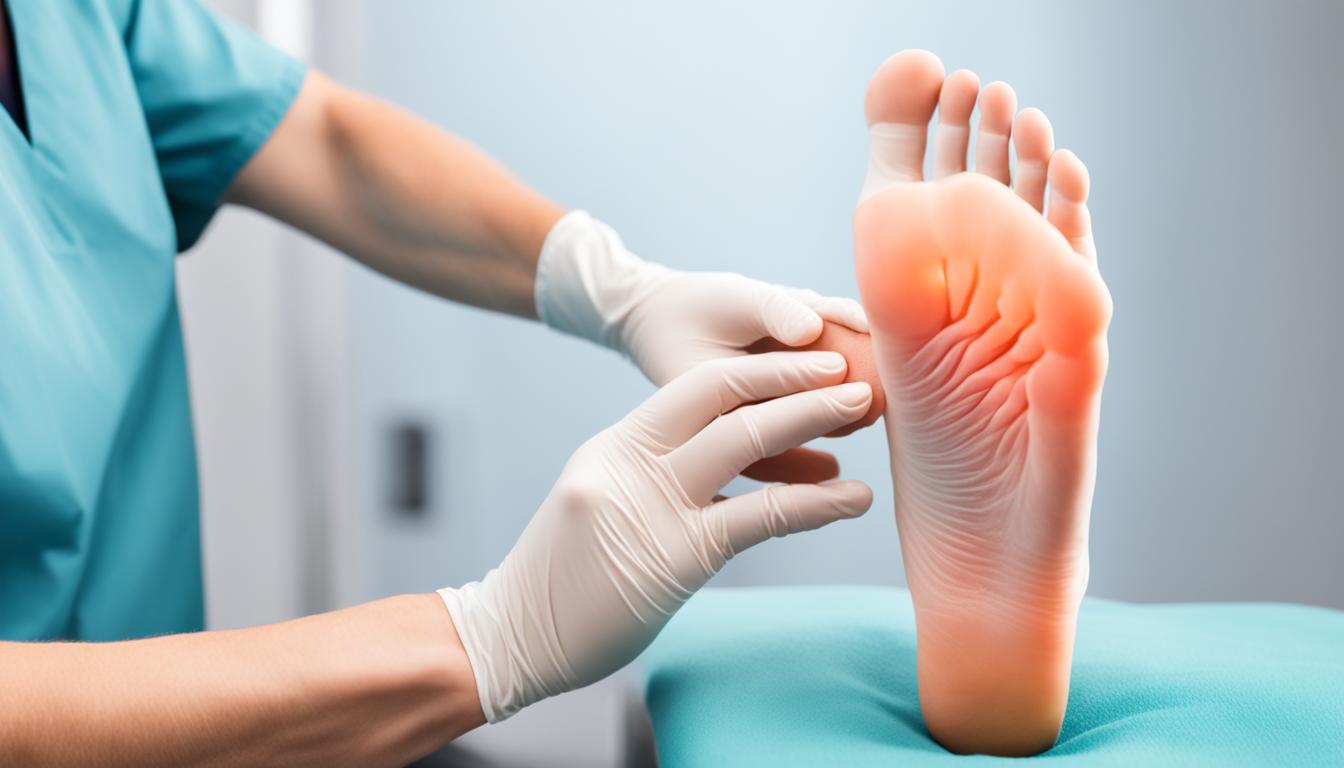Foot drop makes it hard to lift the front of your foot, affecting the way you walk. It can show a problem with nerves, muscles, or bones. This issue often happens due to damage to the peroneal nerve.
Doctors use exams and scans like X-rays to diagnose foot drop. Once diagnosed, treatments like braces, physical therapy, and even nerve stimulation are considered. For some, surgery might be needed. A newer treatment, stem cell therapy, is showing promise, especially in Thailand.
Key Takeaways:
- Foot drop is a gait disturbance characterized by difficulty in lifting the front of the foot.
- Injury to the peroneal nerve is the most common cause of foot drop.
- Diagnosis of foot drop involves physical examinations and imaging tests.
- Treatment options for foot drop include braces, physical therapy, nerve stimulation, and surgery.
- Stem cell therapy is a promising treatment approach for foot drop, being offered in clinics in Thailand.
Symptoms and Diagnosis of Foot Drop
The main symptom of foot drop is when you can’t lift the front of your foot. This makes your toes drag on the ground while walking. It changes the way you walk, which can make you more likely to trip and fall. People with foot drop might also feel numb or tingly in their foot or leg.
Doctors typically diagnose foot drop by doing a full check-up. They watch how you walk and see if your leg muscles are weak. They also test how well you can move your foot up and down. Imaging tests, like x-rays, are used to look for what might be causing your foot drop.
These tests provide different views. X-rays show the bones and joints in your foot and ankle. Ultrasounds take detailed pictures of soft tissues, which might find muscle or tendon problems. CT scans and MRI scans give even more detailed images. They could show issues with nerves or a compressed spinal cord.
A mix of physical exams and these tests helps doctors figure out the root of your foot drop. Knowing the cause is key to picking the right treatment.
Common Symptoms of Foot Drop:
- Inability to lift the front part of the foot
- Toes dragging on the ground while walking
- Numbness or tingling in the foot or leg
- Abnormal gait
- Increased risk of tripping and falling
Diagnostic Tests for Foot Drop:
| Test | Description |
|---|---|
| X-rays | Evaluate bones and joints, identify fractures or arthritis |
| Ultrasounds | Detailed images of soft tissues, muscle, and tendon abnormalities |
| CT scans | Cross-sectional images for detailed assessment of the foot and leg |
| MRI scans | Highly detailed images of soft tissues, nerves, and blood vessels, identify nerve or spinal cord compressions |
Causes and Treatment of Foot Drop
Foot drop happens for different reasons. It might be due to problems in the nerves or muscles. Conditions like muscular dystrophy, polio, or nerve injuries can cause it. So can brain or spinal cord issues, like stroke or multiple sclerosis.
The treatment for foot drop depends on what caused it. For issues with nerves or muscles, doctors often go with non-surgical treatments. Braces or splints can help keep the foot in the right position. They offer support. Exercise to make leg muscles stronger and get better movement can also work. And sometimes, using techniques to stimulate nerves might help too.
If the problem comes from recent nerve damage, surgery to fix the nerve could be an option. For long-term cases, fusion surgery might be thought about. Fusion surgery tries to fix the function and stability of the foot by joining some joints.
Treatment Options for Foot Drop:
- Braces or splints to hold the foot in a normal position
- Physical therapy exercises to strengthen leg muscles and improve range of motion
- Nerve stimulation techniques for nerve regeneration
- Nerve surgery for recent cases of foot drop
- Fusion surgery to improve function in long-standing foot drop
The treatment plan for foot drop should be decided with a healthcare professional. Each person’s situation is different and needs a specific plan.
Stem Cell Therapy for Foot Drop in Thailand
Stem cell therapy is a new way to treat foot drop. It’s a problem that affects how people walk. This treatment uses stem cells. These cells can turn into many different types of cells. They help repair and grow new tissue.
In Thailand, some clinics are starting to use stem cell therapy for foot drop. It’s not a common treatment yet. But, it offers hope for those who want a different option. Research suggests it may help reduce foot drop symptoms.
The goal of this treatment is to fix the root causes of foot drop. This includes nerve or muscle problems, nerve damage, or issues with the brain or spinal cord. By using stem cells, the treatment tries to heal and improve nerve function.
More studies are needed to see how well stem cell therapy works for foot drop. But, it’s an exciting start in the area of healing with new cells.

